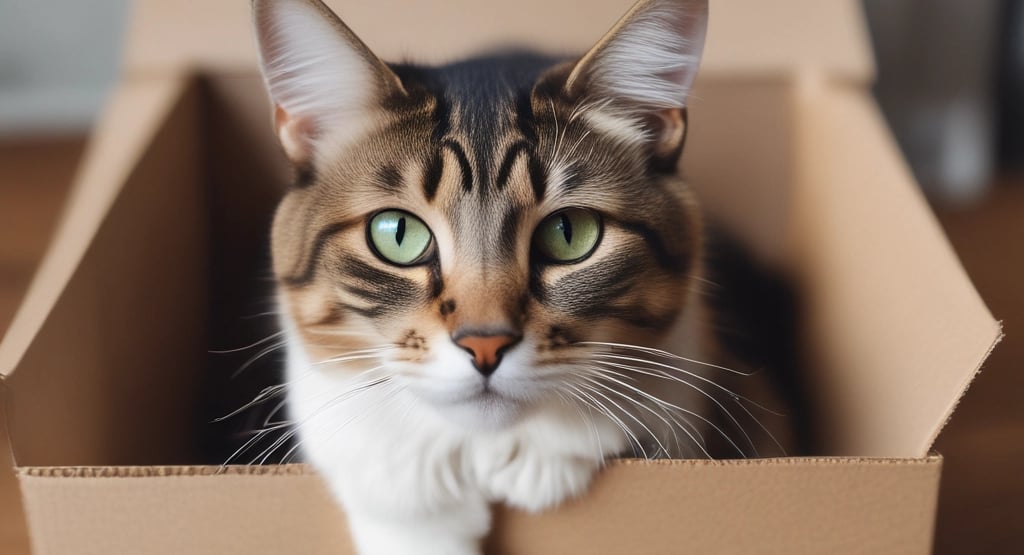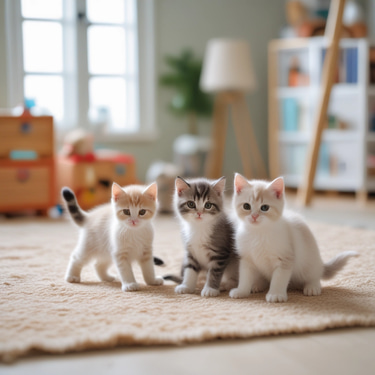Why Are Cats Obsessed with Boxes?
PRIOR BLOGS
7/22/20254 min read


The Psychology Behind Cats and Boxes
Cats are inherently drawn to boxes, a behavior rooted in their instinctual needs and psychological comforts. Throughout the history of domestication, felines have evolved as both hunters and prey, necessitating a dual focus on safety and efficiency. Enclosed spaces, such as boxes, provide a sense of security that resonates deeply with their survival instincts. When a cat enters a box, it essentially creates a safe zone where they can observe their surroundings without being seen, thus blending their natural behaviors with their psychological requirements.
The confined space of a box offers a retreat that allows cats to rest and feel secure, reducing their stress levels. Studies have demonstrated that when cats are provided with boxes or similar concealment options, they exhibit lower levels of anxiety and display more confidence in their environment. It becomes a sanctuary where they can indulge in their predatory instincts, as the enclosed space mimics the conditions of a den or a hiding spot typically utilized by their wild ancestors.
Furthermore, the act of getting into a box can fulfill a cat's nesting urge, as they are biologically predisposed to seek out warm, enclosed spaces to rest and give birth. For many cats, this is a direct manifestation of their need for comfort and safety, echoing a behavior that ensures the survival of their species. Behavioral studies indicate that the availability of boxes in the home can lead to improved emotional and physical well-being for cats, enhancing their quality of life. Thus, when a cat curls up in a box, they are indulging in a primal instinct that has been ingrained within them for centuries, making these simple structures pivotal to their overall health and happiness.
Boxes as a Source of Play and Stimulation
Cats are inherently playful creatures, and boxes serve as vital tools for both play and environmental enrichment. These simple structures provide cats with a variety of ways to engage in stimulating activities that are essential for their physical and mental well-being. The allure of a box can be attributed to its multifaceted roles in a cat's play routine. For instance, a box offers an ideal venue for hiding, allowing cats to indulge in their natural instincts as ambush predators. By concealing themselves within the box, cats can prepare to pounce on unsuspecting "prey" during playtime, reinforcing their hunting skills and providing mental stimulation.
Furthermore, the act of jumping in and out of boxes promotes physical fitness. Cats are naturally agile, and navigating through a box encourages them to practice their jumping and climbing abilities. Such activities are not only fun but also serve to keep their muscles toned and their reflexes sharp. In play scenarios, a box can become a launching pad or a safe haven, inspiring confidence and agility during physical exploration.
Ultimately, the significance of boxes goes beyond mere objects of interest; they are essential tools that enhance cats' lives through play and exploration.
Box Preference in Different Cat Breeds
Cats, regardless of breed, often display a peculiar fascination with boxes. This behavior transcends individual personality traits and has been investigated in various studies to understand how it relates to breed-specific characteristics. Different cat breeds demonstrate unique temperaments and behaviors, which can influence their interactions with boxes.
For instance, breeds such as the Siamese and Burmese are known for their playful, curious nature. These cats are more likely to explore and play within boxes, utilizing them as a domain for their playful instincts. Conversely, breeds like the Persian or Ragdoll tend to exhibit a more relaxed demeanor. While they may not be as enthusiastic about entering boxes, they still seek out these spaces for safety and comfort.
Interestingly, age plays a crucial role in box interaction as well. Kittens, being naturally inquisitive and playful, often find immense joy in hiding and playing inside boxes. Their behavior is primarily driven by a mix of exploration and the need for secure environments. They can often be seen pouncing in and out of boxes, which aids in developing their physical agility and socialization skills. In contrast, adult cats may utilize boxes for different reasons, such as stress relief or security. They often retreat to boxes when they feel overwhelmed, seeking solace in a confined space.
When choosing toys and play structures, cat owners should consider these distinctions in behavior across ages and breeds. Providing a variety of box sizes and types can cater to both playful kittens and adult cats seeking refuge. A well-designed play area incorporating boxes could serve as an excellent environmental enrichment tool, catering to the natural instincts of your feline companion. Understanding these behaviors can enhance the bond between cats and their owners, ultimately improving the quality of their shared experiences.
Creating the Perfect Box Experience for Your Cat
To foster a stimulating environment for your feline companion, incorporating boxes into your home is an excellent strategy. Cats are naturally drawn to enclosed spaces, as they provide a sense of security and safety that aligns with their instinctual behaviors. When designing the perfect box experience, consider both functionality and entertainment to enhance your cat's daily life.
Begin by selecting various types of boxes to cater to your cat’s preferences. Different sizes and shapes can evoke different responses; a smaller box may offer a snug retreat while a larger one can serve as a more expansive playground. Customizing these boxes can further enrich the experience. For instance, you can cut out peep holes or entrances on the sides, allowing your cat to explore and interact with their surroundings from within the box.
Add some engaging elements to these boxes to elevate their appeal. Small toys, such as feather wands or balls, can be placed inside to introduce an element of surprise and excitement. Creating multi-level structures by stacking boxes or connecting them with tunnels can also trim boredom while inviting your cat to climb and explore. This will not only provide physical exercise but also mental stimulation.
When designing box experiences, it is crucial to consider safety. Ensure that the boxes are stable and free from sharp edges or hazardous materials. Regularly inspect the boxes for wear and tear, making replacements as necessary to prevent any injury. Maintain a clean environment by replacing any soiled or damaged boxes promptly. By incorporating these considerations, you can guarantee that your feline friend can freely explore their box spaces in comfort.
In conclusion, effectively integrating boxes into your cat's environment can significantly enhance their quality of life. With thoughtful customization and safety precautions, boxes can transform into enriching spaces for play, rest, and exploration, fulfilling your cat's instinctual needs and elevating their overall well-being.
Affiliate Disclosure:
Some of the links on this website are affiliate links, which means I may earn a small commission if you make a purchase through them — at no extra cost to you. As an experienced cat lover, I only recommend products I truly believe in and think would be helpful to fellow cat lovers. Thank you for supporting this blog!
Sharing our love and knowledge about cats.
Felines
© 2025. All rights reserved.
